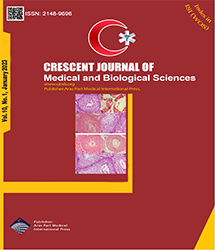| Review | |
| Evaluating the Indices of Diagnosing Uterine Temperament in Persian Medicine: A Review Study | |
| Maryam Mashhadi1, Atefeh Saeidi1, Mojgan Tansaz1, Soodabeh Bioos2, Malihe Tabarrai2, Zahra Darvish-Mofrad-Kashani3, Ali Montazeri4, Mohsen Saberi5, Morteza Mojahedi6, Roshanak Mokaberinejad1 | |
| 1Department of Traditional Medicine, School of Traditional Medicine, Shahid Beheshiti University of Medical Sciences, Tehran, Iran 2Department of Persian medicine, School of Persian medicine, Tehran University of Medical Sciences, Tehran, Iran 3Traditional Medicine Clinical Trial Research Center, Shahed University, Tehran, Iran 4Institute for Health Sciences Research, Academic Center for Education, Culture and Research, ACECR, Tehran, Iran 5Medicine, Quran and Hadith Research Center & Department of Community Medicine, Faculty of Medicine, Baqiyatallah University of Medical Sciences, Tehran, Iran 6Traditional Medicine and History of Medical Sciences Research Center, Health Research Institute, Babol University of Medical Sciences, Babol, Iran |
|
|
CJMB 2023; 10: 002-010 DOI: 10.34172/cjmb.2023.02 Viewed : 4374 times Downloaded : 2681 times. Keywords : Uterus, Dystemperament, Temperament, Persian medicine, Traditional medicine, Iran |
|
| Full Text(PDF) | Related Articles | |
| Abstract | |
Objectives: According to Persian medicine (PM), the uterus is an important organ in women, responsible for purifying the blood and nourishing the fetus. Each organ has a specific temperament distinct from the whole-body temperament based on PM. Dystemperament occurs when body or organ Mizaj (Persian word for temperament) deviates from what is considered normal, resulting in malfunction. Many gynecological disorders described in PM and conventional medicine, including infertility, recurrent miscarriage, oligomenorrhea/amenorrhea, hypermenorrhea, vaginitis, cervicitis, urinary incontinence, and pelvic pain, are considered to be associated with uterine dystemperaments. Hence, proper management of such disorders requires precise diagnosis and treatment of uterine dystemperaments. Accordingly, this review study aimed to collect and categorize these symptoms from PM texts and other relevant articles. Methods: In this study, we reviewed 10 well-known PM references, including Canon in Medicine (Al-Qanun Fi al-Teb), the Great Panacea (Exir-e A"zam), the Treasure of Kharazmshah (Zakhireh Kharazmshahi), the Perfect Book of the Art of Medicine (Kamel al-Sana"a al-Tebbiya), Akbari"s Medicine (Tebb-E-Akbari), Gharshi"s Commentary on Canon of Medicine (Sharh-e Qarshi bar Qanun), Commentary on Hippocrates" Aphorisms (Sharh-e Fosul-e Boqraat), Summary of Experiences (Kholasa-tut Tajarob), Description of Signs and Symptoms (Sharh-e Asbab va Alamat), and Aghili"s Treatments (Mo"alejat-e Aghili). Moreover, Scopus, PubMed, Web of Science, SienceDirect, and Google Scholar databases were queried with the keywords "mizaj", "temperament", "uterus", "uterine", "cold/hot or warm", and "dry/wet", while Persian databases of Magiran, Iran Medex, and SID were searched using keywords "mizaj", "rahem", "garm", "sard", "tar", and "khoshk" to extract signs and symptoms associated with uterine temperament and dystemperament. Results: Five indicators were specified in the articles and PM sources for determining the temperament and dystemperament of the uterus as follows: 1) Menstrual blood characteristics (including amount, temperature, color, odor, flow rate, and consistency); 2) Uterine discharge characteristics (including amount, consistency, color, odor, and accompanied symptoms, especially burning and itching); 3) Fertility and pregnancy status (including infertility, abortion, etc.); 4. Other characteristics of the female reproductive system (including pubic hair, menarche age, sexual desire and quality of intercourse, and vaginal and cervical condition on vaginal examination); and 5) General symptoms (including the ten PM indicators of whole-body Mizaj). Conclusions: PM sources have described the characteristics of uterine temperament and dystemperament in detail. These indices can be used for more effective diagnosis, treatment, and even prevention of gynecological diseases, as well as designing and validation of standard tools for determining uterine temperament and dystemperament. |
Cite By, Google Scholar
Google Scholar
PubMed
Online Submission System
 CJMB ENDNOTE ® Style
CJMB ENDNOTE ® Style
 Tutorials
Tutorials
 Publication Charge
Medical and Biological Research Center
About Journal
Publication Charge
Medical and Biological Research Center
About Journal
Aras Part Medical International Press Editor-in-Chief
Arash Khaki
Deputy Editor
Zafer Akan



















